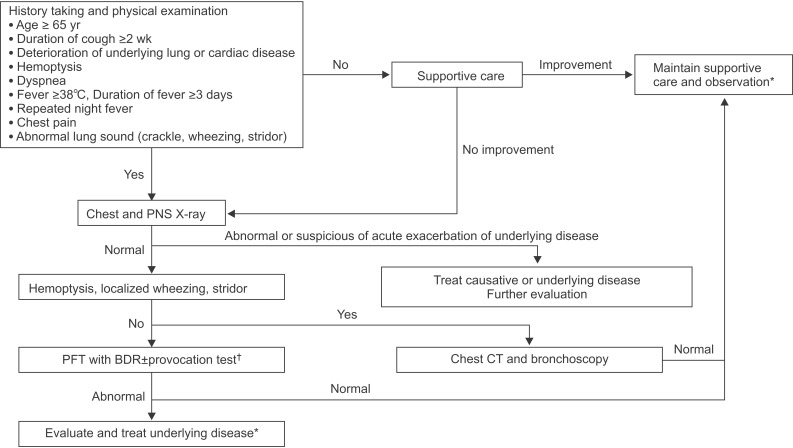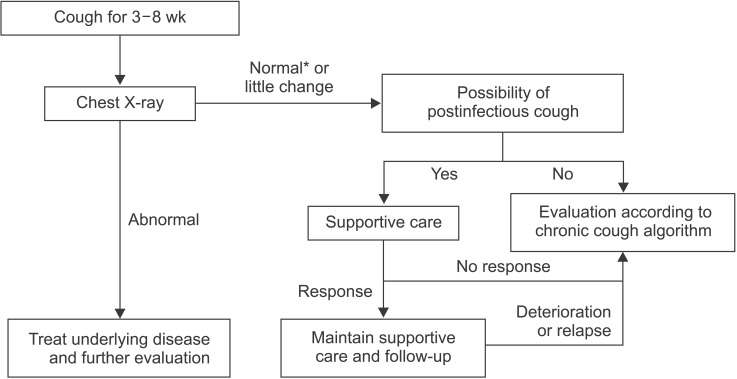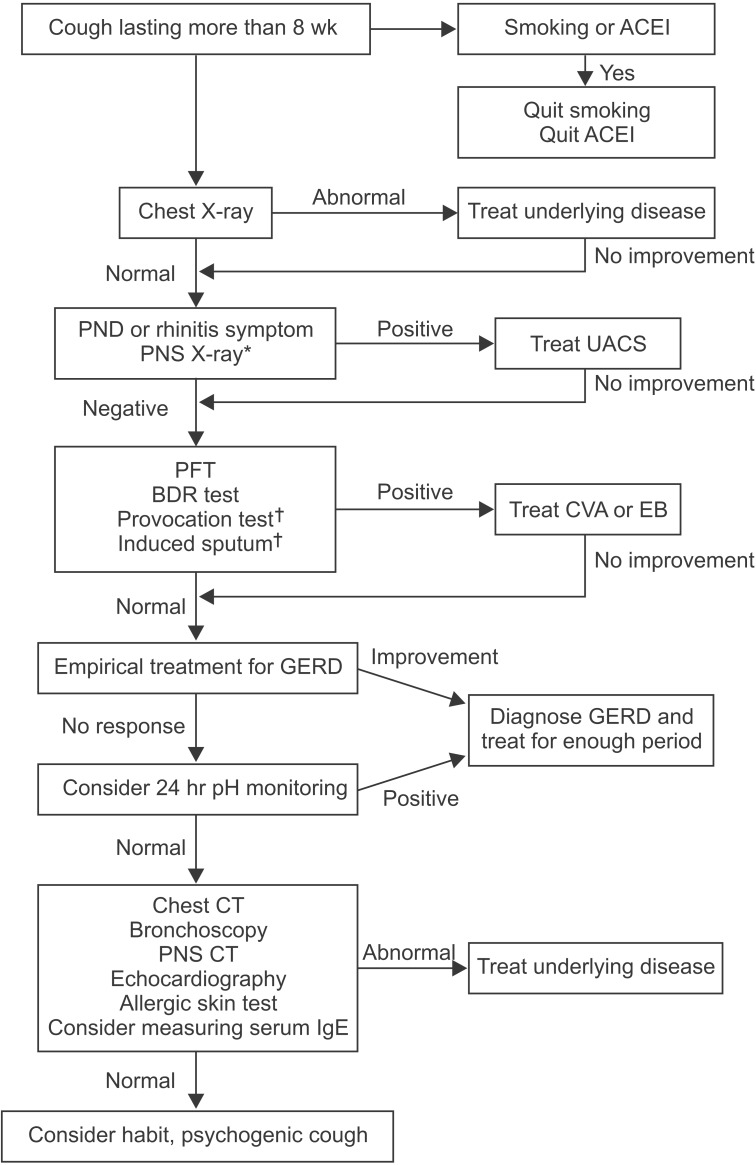Tuberc Respir Dis.
2016 Jan;79(1):14-21. 10.4046/trd.2016.79.1.14.
The Korean Cough Guideline: Recommendation and Summary Statement
- Affiliations
-
- 1Division of Pulmonary, Allergy and Critical Care Medicine, Department of Internal Medicine, Seoul St Mary's Hospital, College of Medicine, The Catholic University of Korea, Seoul, Korea.
- 2Division of Pulmonary, Department of Internal Medicine, Severance Hospital, Yonsei University College of Medicine, Seoul, Korea.
- 3Department of Pulmonology and Critical Care Medicine, Asan Medical Center, University of Ulsan College of Medicine, Seoul, Korea.
- 4Division of Pulmonary, Allergy, and Critical Care Medicine, Department of Internal Medicine, Hallym University Sacred Heart Hospital, Hallym University College of Medicine, Anyang, Korea.
- 5Division of Pulmonary, Allergy and Critical Care Medicine, Department of Internal Medicine, Hallym University Kangdong Sacred Heart Hospital, Hallym University College of Medicine, Seoul, Korea.
- 6Department of Internal Medicine, Division of Pulmonology, Konkuk University School of Medicine, Seoul, Korea.
- 7Division for Healthcare Technology Assessment Research, National Evidence-based Healthcare Collaborating Agency, Seoul, Korea.
- 8Divison of Pulmonary and Critical Care Medicine, Department of Internal Medicine, Inje University Ilsan Paik Hospital, Inje University College of Medicine, Ilsan, Korea.
- 9Department of Pulmonary and Critical Care Medicine, Kyung Hee University Hospital at Gangdong, Kyung Hee University School of Medicine, Seoul, Korea.
- 10Department of Internal Medicine, National Medical Center, Seoul, Korea.
- 11Division of Pulmonary, Sleep and Critical Care Medicine, Department of Internal Medicine, Korea University Ansan Hospital, Korea University College of Medicine, Ansan, Korea.
- 12Division of Pulmonary and Critical Care Medicine, Department of Internal Medicine, Seoul Metropolitan Government-Seoul National University Boramae Medical Center, Seoul National University College of Medicine, Seoul, Korea.
- 13Division of Pulmonology, Department of Internal Medicine, St. Vincent's Hospital, College of Medicine, The Catholic University of Korea, Suwon, Korea.
- 14Division of Pulmonary, Allergy and Critical Care Medicine, Department of Internal Medicine, Bucheon St. Mary's Hospital, College of Medicine, The Catholic University of Korea, Bucheon, Korea.
- 15Department of Critical Care, Samsung Medical Center, Sungkyunkwan University School of Medicine, Seoul, Korea.
- 16Department of Pulmonary and Allergy, Department of Internal Medicine, Regional Respiratory Center, Yeungnam University Hospital, Daegu, Korea.
- 17Division of Pulmonary and Critical Care Medicine, Department of Internal Medicine, Wonkwang University Sanbon Hospital, Wonkwang University School of Medicine, Gunpo, Korea. hikim7337@gmail.com
- KMID: 2320751
- DOI: http://doi.org/10.4046/trd.2016.79.1.14
Abstract
- Cough is one of the most common symptom of many respiratory diseases. The Korean Academy of Tuberculosis and Respiratory Diseases organized cough guideline committee and cough guideline was developed by this committee. The purpose of this guideline is to help clinicians to diagnose correctly and treat efficiently patients with cough. In this article, we have stated recommendation and summary of Korean cough guideline. We also provided algorithm for acute, subacute, and chronic cough. For chronic cough, upper airway cough syndrome (UACS), cough variant asthma (CVA), and gastroesophageal reflux disease (GERD) should be considered. If UACS is suspicious, first generation anti-histamine and nasal decongestant can be used empirically. In CVA, inhaled corticosteroid is recommended in order to improve cough. In GERD, proton pump inhibitor is recommended in order to improve cough. Chronic bronchitis, bronchiectasis, bronchiolitis, lung cancer, aspiration, angiotensin converting enzyme inhibitor, habit, psychogenic cough, interstitial lung disease, environmental and occupational factor, tuberculosis, obstructive sleep apnea, peritoneal dialysis, and idiopathic cough can be also considered as cause of chronic cough. Level of evidence for treatment is mostly low. Thus, in this guideline, many recommendations are based on expert opinion. Further study regarding treatment for cough is mandatory.
MeSH Terms
Figure
Cited by 1 articles
-
Clinical Characteristics of Chronic Cough in Korea
Tai Joon An, Jin Woo Kim, Eun Young Choi, Seung Hun Jang, Hwa Young Lee, Hye Seon Kang, Hyeon-Kyoung Koo, Jong Min Lee, Sung-Kyung Kim, Jong-Wook Shin, So Young Park, Chin Kook Rhee, Ji-Yong Moon, Yee Hyung Kim, Hyun Lee, Yong Hyun Kim, Je Hyeong Kim, Sang Haak Lee, Deog Kyeom Kim, Kwang Ha Yoo, Dong-Gyu Kim, Ki-Suck Jung, Hui Jung Kim, Hyoung Kyu Yoon,
Tuberc Respir Dis. 2020;83(1):31-41. doi: 10.4046/trd.2019.0018.
Reference
-
1. Guyatt GH, Oxman AD, Kunz R, Falck-Ytter Y, Vist GE, Liberati A, et al. Going from evidence to recommendations. BMJ. 2008; 336:1049–1051. PMID: 18467413.
Article2. Madison JM, Irwin RS. Pharmacotherapy of chronic cough in adults. Expert Opin Pharmacother. 2003; 4:1039–1048. PMID: 12831332.
Article3. Gaffey MJ, Kaiser DL, Hayden FG. Ineffectiveness of oral terfenadine in natural colds: evidence against histamine as a mediator of common cold symptoms. Pediatr Infect Dis J. 1988; 7:223–228. PMID: 2895909.4. Berkowitz RB, Connell JT, Dietz AJ, Greenstein SM, Tinkelman DG. The effectiveness of the nonsedating antihistamine loratadine plus pseudoephedrine in the symptomatic management of the common cold. Ann Allergy. 1989; 63:336–339. PMID: 2529799.5. Gwaltney JM Jr, Phillips CD, Miller RD, Riker DK. Computed tomographic study of the common cold. N Engl J Med. 1994; 330:25–30. PMID: 8259141.
Article6. Puhakka T, Makela MJ, Alanen A, Kallio T, Korsoff L, Arstila P, et al. Sinusitis in the common cold. J Allergy Clin Immunol. 1998; 102:403–408. PMID: 9768580.
Article7. Pratter MR, Brightling CE, Boulet LP, Irwin RS. An empiric integrative approach to the management of cough: ACCP evidence-based clinical practice guidelines. Chest. 2006; 129(1 Suppl):222S–231S. PMID: 16428715.8. Asthma Workgroup of Chinese Society of Respiratory Diseases (CSRD). Chinese Medical Association. The Chinese national guidelines on diagnosis and management of cough (December 2010). Chin Med J (Engl). 2011; 124:3207–3219. PMID: 22088510.9. McGarvey LP. Cough. 6: which investigations are most useful in the diagnosis of chronic cough? Thorax. 2004; 59:342–346. PMID: 15047960.10. Morice AH, McGarvey L, Pavord I. British Thoracic Society Cough Guideline Group. Recommendations for the management of cough in adults. Thorax. 2006; 61(Suppl 1):i1–i24. PMID: 16936230.
Article11. Gibson PG, Dolovich J, Denburg J, Ramsdale EH, Hargreave FE. Chronic cough: eosinophilic bronchitis without asthma. Lancet. 1989; 1:1346–1348. PMID: 2567371.
Article12. Brightling CE, Ward R, Goh KL, Wardlaw AJ, Pavord ID. Eosinophilic bronchitis is an important cause of chronic cough. Am J Respir Crit Care Med. 1999; 160:406–410. PMID: 10430705.
Article13. Richter JE, Castell DO. Drugs, foods, and other substances in the cause and treatment of reflux esophagitis. Med Clin North Am. 1981; 65:1223–1234. PMID: 7035766.
Article14. Vitale GC, Cheadle WG, Patel B, Sadek SA, Michel ME, Cuschieri A. The effect of alcohol on nocturnal gastroesophageal reflux. JAMA. 1987; 258:2077–2079. PMID: 3656623.
Article15. Clark CS, Kraus BB, Sinclair J, Castell DO. Gastroesophageal reflux induced by exercise in healthy volunteers. JAMA. 1989; 261:3599–3601. PMID: 2724505.
Article16. Fraser-Moodie CA, Norton B, Gornall C, Magnago S, Weale AR, Holmes GK. Weight loss has an independent beneficial effect on symptoms of gastro-oesophageal reflux in patients who are overweight. Scand J Gastroenterol. 1999; 34:337–340. PMID: 10365891.17. Mathus-Vliegen LM, Tytgat GN. Twenty-four-hour pH measurements in morbid obesity: effects of massive overweight, weight loss and gastric distension. Eur J Gastroenterol Hepatol. 1996; 8:635–640. PMID: 8853250.18. Bardin P, Kanniess F, Gauvreau G, Bredenbroker D, Rabe KF. Roflumilast for asthma: efficacy findings in mechanism of action studies. Pulm Pharmacol Ther. 2015; 8. 19. [Epub]. DOI: 10.1016/j.pupt.2015.08.006.
Article19. Stanciu C, Bennett JR. Effects of posture on gastro-oesophageal reflux. Digestion. 1977; 15:104–109. PMID: 14044.
Article20. Kanner RE, Connett JE, Williams DE, Buist AS. Effects of randomized assignment to a smoking cessation intervention and changes in smoking habits on respiratory symptoms in smokers with early chronic obstructive pulmonary disease: the Lung Health Study. Am J Med. 1999; 106:410–416. PMID: 10225243.
Article21. Wynder EL, Kaufman PL, Lesser RL. A short-term follow-up study on ex-cigarette smokers: with special emphasis on persistent cough and weight gain. Am Rev Respir Dis. 1967; 96:645–655. PMID: 6051202.22. Cazzola M, Floriani I, Page CP. The therapeutic efficacy of erdosteine in the treatment of chronic obstructive bronchitis: a meta-analysis of individual patient data. Pulm Pharmacol Ther. 2010; 23:135–144. PMID: 19854285.
Article23. Klock LE, Miller TD, Morris AH, Watanabe S, Dickman M. A comparative study of atropine sulfate and isoproterenol hydrochloride in chronic bronchitis. Am Rev Respir Dis. 1975; 112:371–376. PMID: 1099948.24. Ram FS, Jones PW, Castro AA, De Brito JA, Atallah AN, Lacasse Y, et al. Oral theophylline for chronic obstructive pulmonary disease. Cochrane Database Syst Rev. 2002; (4):CD003902. PMID: 12519617.
Article25. Calverley P, Pauwels R, Vestbo J, Jones P, Pride N, Gulsvik A, et al. Combined salmeterol and fluticasone in the treatment of chronic obstructive pulmonary disease: a randomised controlled trial. Lancet. 2003; 361:449–456. PMID: 12583942.
Article26. McGuinness G, Naidich DP. CT of airways disease and bronchiectasis. Radiol Clin North Am. 2002; 40:1–19. PMID: 11813813.
Article27. Wong C, Jayaram L, Karalus N, Eaton T, Tong C, Hockey H, et al. Azithromycin for prevention of exacerbations in noncystic fibrosis bronchiectasis (EMBRACE): a randomised, double-blind, placebo-controlled trial. Lancet. 2012; 380:660–667. PMID: 22901887.
Article28. Altenburg J, de Graaff CS, Stienstra Y, Sloos JH, van Haren EH, Koppers RJ, et al. Effect of azithromycin maintenance treatment on infectious exacerbations among patients with noncystic fibrosis bronchiectasis: the BAT randomized controlled trial. JAMA. 2013; 309:1251–1259. PMID: 23532241.29. Serisier DJ, Martin ML, McGuckin MA, Lourie R, Chen AC, Brain B, et al. Effect of long-term, low-dose erythromycin on pulmonary exacerbations among patients with non-cystic fibrosis bronchiectasis: the BLESS randomized controlled trial. JAMA. 2013; 309:1260–1267. PMID: 23532242.30. Evans DJ, Bara AI, Greenstone M. Prolonged antibiotics for purulent bronchiectasis in children and adults. Cochrane Database Syst Rev. 2007; (2):CD001392. PMID: 17443506.
Article31. Brown KK. Chronic cough due to nonbronchiectatic suppurative airway disease (bronchiolitis): ACCP evidence-based clinical practice guidelines. Chest. 2006; 129(1 Suppl):132S–137S. PMID: 16428702.32. Shure D. Radiographically occult endobronchial obstruction in bronchogenic carcinoma. Am J Med. 1991; 91:19–22. PMID: 1858825.
Article33. Temel JS, Greer JA, Muzikansky A, Gallagher ER, Admane S, Jackson VA, et al. Early palliative care for patients with metastatic non-small-cell lung cancer. N Engl J Med. 2010; 363:733–742. PMID: 20818875.
Article34. Molassiotis A, Smith JA, Bennett MI, Blackhall F, Taylor D, Zavery B, et al. Clinical expert guidelines for the management of cough in lung cancer: report of a UK task group on cough. Cough. 2010; 6:9. PMID: 20925935.
Article35. Robbins J, Coyle J, Rosenbek J, Roecker E, Wood J. Differentiation of normal and abnormal airway protection during swallowing using the penetration-aspiration scale. Dysphagia. 1999; 14:228–232. PMID: 10467048.
Article36. Israili ZH, Hall WD. Cough and angioneurotic edema associated with angiotensin-converting enzyme inhibitor therapy: a review of the literature and pathophysiology. Ann Intern Med. 1992; 117:234–242. PMID: 1616218.37. Lacourciere Y, Brunner H, Irwin R, Karlberg BE, Ramsay LE, Snavely DB, et al. Effects of modulators of the renin-angiotensin-aldosterone system on cough. Losartan Cough Study Group. J Hypertens. 1994; 12:1387–1393. PMID: 7706699.38. Weinberger M. The habit cough syndrome and its variations. Lung. 2012; 190:45–53. PMID: 21842256.
Article39. Kravitz H, Gomberg RM, Burnstine RC, Hagler S, Korach A. Psychogenic cough tic in children and adolescents: nine case histories illustrate the need for re-evaluation of this common but frequently unrecognized problem. Clin Pediatr (Phila). 1969; 8:580–583. PMID: 5344422.40. Gay M, Blager F, Bartsch K, Emery CF, Rosenstiel-Gross AK, Spears J. Psychogenic habit cough: review and case reports. J Clin Psychiatry. 1987; 48:483–486. PMID: 3320033.41. Lavigne JV, Davis AT, Fauber R. Behavioral management of psychogenic cough: alternative to the "bedsheet" and other aversive techniques. Pediatrics. 1991; 87:532–537. PMID: 2011431.
Article42. Cohlan SQ, Stone SM. The cough and the bedsheet. Pediatrics. 1984; 74:11–15. PMID: 6739203.
Article43. Sundar KM, Daly SE, Pearce MJ, Alward WT. Chronic cough and obstructive sleep apnea in a community-based pulmonary practice. Cough. 2010; 6:2. PMID: 20398333.
Article44. Birring SS, Ing AJ, Chan K, Cossa G, Matos S, Morgan MD, et al. Obstructive sleep apnoea: a cause of chronic cough. Cough. 2007; 3:7. PMID: 17605822.
Article45. Holley JL, Piraino B. CAPD-associated cough. Perit Dial Int. 1995; 15:392–393. PMID: 8785248.
Article46. Tarlo SM. Peritoneal dialysis and cough. Perit Dial Int. 2003; 23:424–426. PMID: 14604191.
Article47. Min F, Tarlo SM, Bargman J, Poonai N, Richardson R, Oreopoulos D. Prevalence and causes of cough in chronic dialysis patients: a comparison between hemodialysis and peritoneal dialysis patients. Adv Perit Dial. 2000; 16:129–133. PMID: 11045277.48. Twardowski ZJ, Khanna R, Nolph KD, Scalamogna A, Metzler MH, Schneider TW, et al. Intraabdominal pressures during natural activities in patients treated with continuous ambulatory peritoneal dialysis. Nephron. 1986; 44:129–135. PMID: 3774076.
Article49. Ekim M, Tumer N, Bakkaloglu S. Tuberculosis in children undergoing continuous ambulatory peritoneal dialysis. Pediatr Nephrol. 1999; 13:577–579. PMID: 10460504.
Article50. Pratter MR. Unexplained (idiopathic) cough: ACCP evidencebased clinical practice guidelines. Chest. 2006; 129:220S–221S. PMID: 16428714.51. Gibson PG, Ryan NM. Cough pharmacotherapy: current and future status. Expert Opin Pharmacother. 2011; 12:1745–1755. PMID: 21524236.
Article52. Bolser DC. Mechanisms of action of central and peripheral antitussive drugs. Pulm Pharmacol. 1996; 9:357–364. PMID: 9232675.
Article53. Balsamo R, Lanata L, Egan CG. Mucoactive drugs. Eur Respir Rev. 2010; 19:127–133. PMID: 20956181.
Article54. Rubin BK. Mucolytics, expectorants, and mucokinetic medications. Respir Care. 2007; 52:859–865. PMID: 17594730.
- Full Text Links
- Actions
-
Cited
- CITED
-
- Close
- Share
- Similar articles
-
- Summary of Insulin Therapy for Adult Patients with Type 2 Diabetes Mellitus: A Position Statement of the Korean Diabetes Association, 2017
- COPD Guideline Revised 2012: Contracted Version
- Summary of the 2023 Thai Menopause Society Clinical Practice Guideline on Menopausal Hormone Therapy
- Evaluating the NGC(TM) Evidence Based Guideline of Prompted Voiding for Use in Korea
- Clinical practice guidelines for ovarian cancer: an update to the Korean Society of Gynecologic Oncology guidelines




